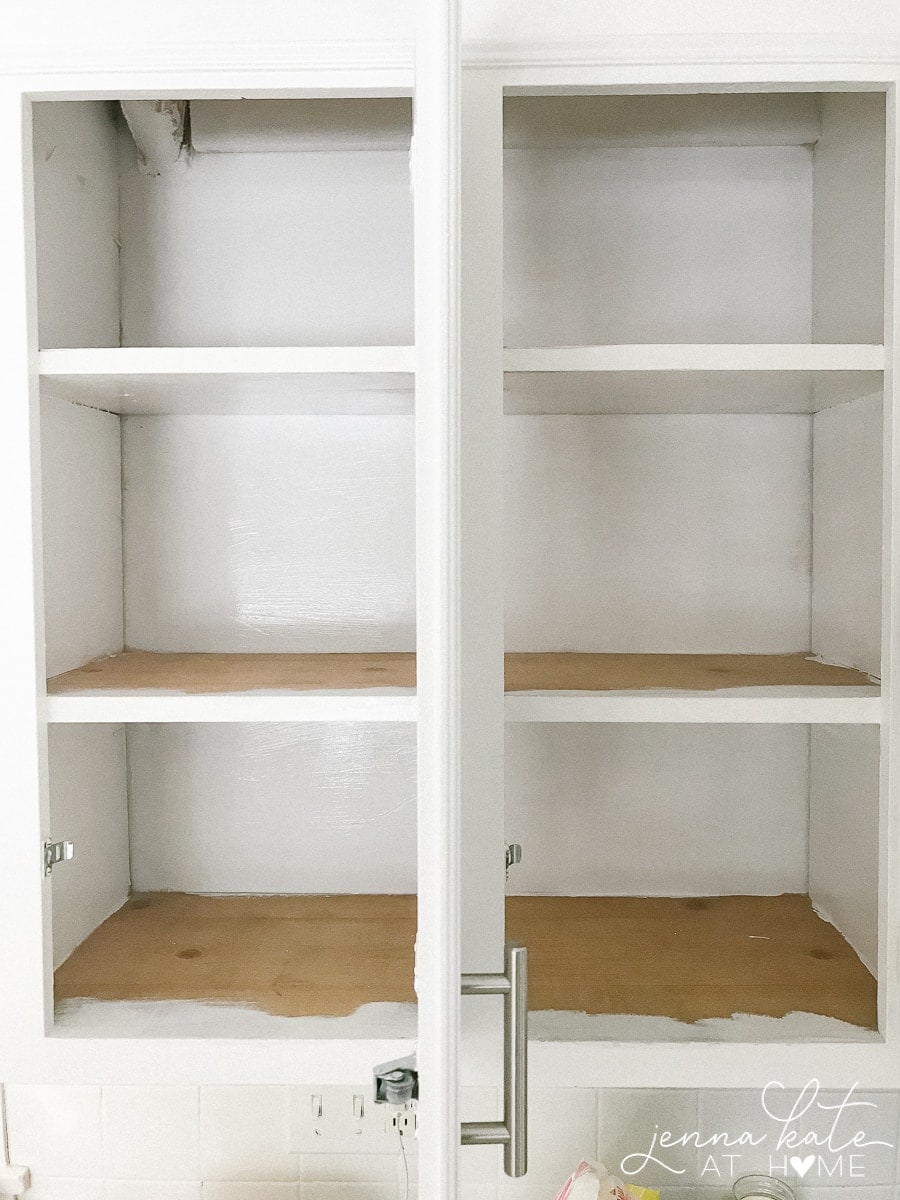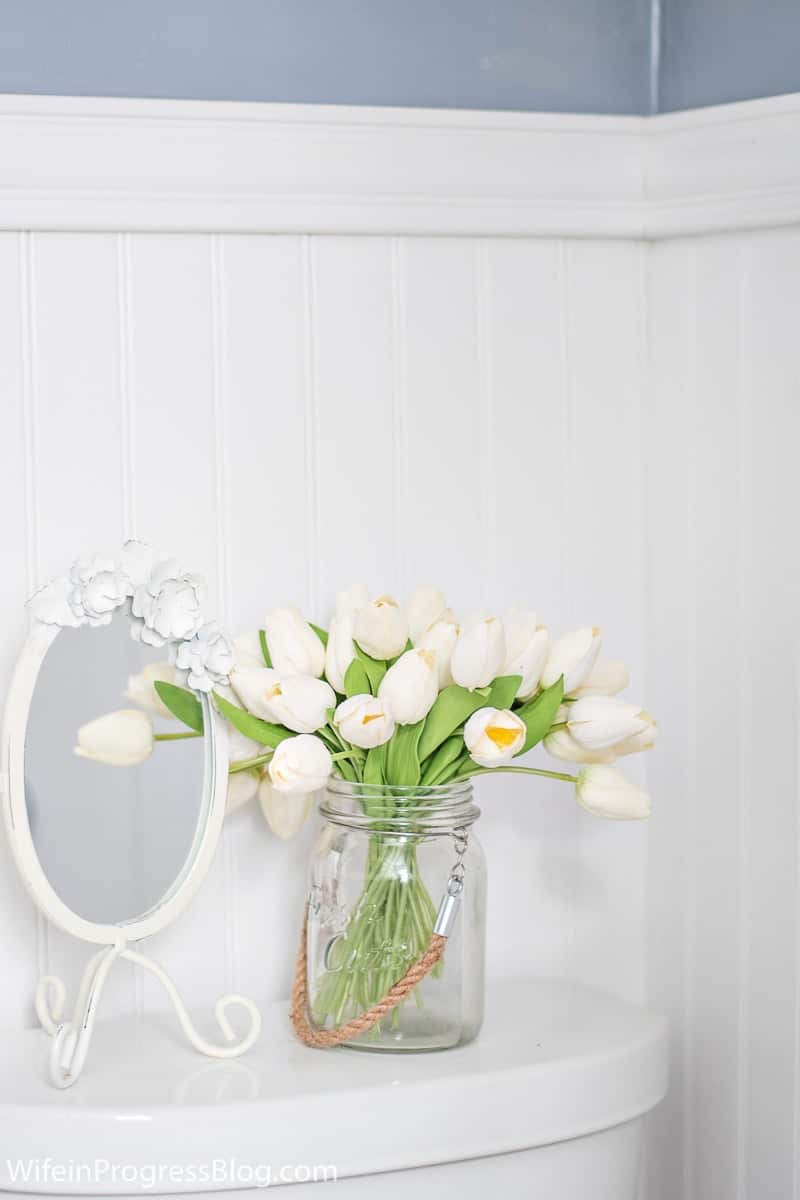Content may contain affiliate links. When you shop the links, I receive a small commission at no cost to you. Thank you for supporting my small business.
After trying several types, including oil-based paint, latex paint, and chalk paint, I discovered the best type of paint for cabinets: Benjamin Moore’s Advance Alkyd Paint.

Painting your cabinets doesn’t have to be difficult, especially when you pick the best cabinet paint for the job!
A good paint is essential if you are tackling kitchen cabinets or cabinet doors, where durability and a smooth surface are key, and this truly is the best paint for the job.
Why Choose Benjamin Moore’s Advance Alkyd Paint?
Benjamin Moore’s Advance is the best choice for several reasons:
- Durability: It’s a durable paint, perfect for daily use in kitchens or bathrooms.
- Professional Finish: This paint offers a luxurious, professional finish – something even professional painters appreciate. It comes in high-gloss, semi-gloss, or satin finishes, all providing excellent leveling and minimal brush strokes.
- Ease of Use: Unlike traditional oil-based paints that need a lot of prep work, Advance Alkyd Paint is user-friendly, making it a great choice for both beginners and seasoned DIYers.

Benjamin Moore Advances vs Sherwin Williams Urethane Trim Enamel
Another viable option for cabinet painting is Sherwin Williams Urethane Trim Enamel. This paint is known for its durability and smooth finish, making it a good choice for areas that require a hard-wearing surface, like kitchen and bathroom cabinets.
It’s a hybrid of oil and water-based paints, offering the ease of a water-based paint with the hard finish of an oil-based product. The Urethane Trim Enamel is also low in VOCs and comes in a variety of colors, much like the Advance line from Benjamin Moore.

While Sherwin Williams Urethane Trim Enamel is a popular choice for many DIYers and professional painters alike, I personally prefer Benjamin Moore’s Advance Alkyd Paint for my projects. After using the Urethane Trim Enamel on my kitchen cabinets and then using the Advance Line on my bathroom vanity, I found that the Advance line has superior leveling for a smoother surface and a more professional finish, especially when using a foam roller or paint sprayer.
The durability and overall quality of Benjamin Moore’s product, in my experience, make it the best choice for kitchen and bathroom cabinet renovations.
Why Alkyd Paint is Like Oil Paint But Better
Alkyd paint is a hybrid that combines the best of oil-based and water-based paints. It gives you the durability and smooth finish of oil paint, but with easier cleanup and lower volatile organic compounds (VOCs), making it a healthier choice for your home.

Using a Paint Sprayer or Roller for Cabinets
Whether using a paint sprayer for great coverage or a foam roller for convenience, both methods work well with Benjamin Moore’s Advance. The paint’s self-leveling property ensures a smooth finish, regardless of the application method.

To Prime or Not to Prime
If you’re painting over raw wood or stained wood cabinets, using a shellac-based primer like Bin from your local paint store or Home Depot is a good idea. It ensures no bleed-through and creates the perfect surface for the paint.
My Application Tips for the Best Results
- Use the Right Tools: High-quality tools like Purdy brushes or rollers are essential for a smooth application. For an even more professional finish, a paint sprayer is an excellent choice.
- Apply a Second Coat: A fresh coat of Benjamin Moore’s Advance Alkyd Paint after the first coat has dried for 24 hours ensures even coverage and durability. Depending on the color and type of cabinets, a third coat may be needed.
- Allow Proper Drying Time: Patience is key for the best finish. Let the paint dry thoroughly between coats, and allow 2-3 weeks for it to properly cure to a rock-hard finish.
Final Thoughts
Choosing Benjamin Moore’s Advance Alkyd Paint for your kitchen or bathroom cabinets is an investment in your home’s beauty and functionality.
This hybrid alkyd enamel paint is the right paint for any cabinet painting project. With its ease of use, professional finish, and durability, it stands out as the best kitchen cabinet paint brand, offering a new look and great results for your entire kitchen.













I have 1970 good ole pine cabinets. Few years ago we got smart painted them with a semigloss no primer just put that paint right on. … now uh oh hate them. As new cabinets are not I’m the budget how do I correct this mess. Strip? Repaint. Or learn to love the mess.
Hi Lisa,
Is the paint peeling and chipping? If it is, you’re probably going to have to strip the down. If you can live with the boxes, take the doors off and put some citristrip on and the paint should come right off. Then clean them up, sand, prime and paint. Of course, if you can learn to love them it’s a lot less labor intensive!
I use Extreme bond primer from Sherwin Williams and Emerald Urethane by Sherwin Williams and I love it and so do my clients!
Hello! I’m trying out the SW Emerald Urethane on my brand new cabinets. When we bought them the brown tones didn’t match so we are painting them black. They are showing all my brush strokes – as in if I pick up the brush and where I put my brush down or if I turn the brush sideways. So it seems I need to use one strokes all the way across. The problem will come because they are a little bit like a shaker style, so I’m not sure how to paint the inside panel without leaving marks where I’ve moved the brush tip. Do I just need to remove them and get a sprayer to spray them? Any suggestions? Thank you so much for any advice you can give!
Hi Yvonne,
You will always have some sort of brushstrokes if you paint cabinets with a brush, no matter how good the paint is. If you’re set on using a brush, paint in one direction (with the grain if it’s visible). Then paint the outside of the cabinet in one direction (clockwise). Light coats of paint help a lot too. I’ve used this paint on my cabinets and it dried really well with very minimal brushstrokes (I did only use a paintbrush too because it’s what I had on hand!). I would recommend using a foam roller made specifically for painting cabinets and doors, and you’re much less likely to see issues. Paint any corners with the brush first, then use the roller. Make sure to leave ample drying time between coats, and lightly sandy between coats, too. At this time of the year, you’re probably talking 24-48 hours between coats, especially if it’s hot and humid.
Finally – I should add, if spraying is an option, it will ALWAYS look more professional! It’s also generally quicker in the long run!
I use a nylon brush and it limits the brush strokes to very little. I also use Benjamin Moore Advance Alykd paint.
What type of paint and what prep for old formica type cabinets.
Hi Sandy, prep + paint is the same but you’re going to have to use a bonding primer to ensure adhesion to the formica. Besides that, make sure they are very clean to start with and have been sanded slightly to help the primer adhere. Then I would follow with the Alkyd paint. This article should help you: https://www.bobvila.com/articles/how-to-paint-formica/
Any recommendation on what kind of primer to use on new unpainted cabinet door made of combination of mdf and wood? I’m thinking of using either Sherman Williams ProClassic paint or go the Benjamin Moore advance line. What would you recommend? I just repainted some maple color built in cabinets with Valspar stain blocking blocker and enamel paint and it was a bit of a battle as it seems to still be easily chipped so trying to find a better option for the kitchen. Thanks!
I would always use a shellac based primer on unsealed wood. My preference is Zinsser B-I-N Interior Multi-purpose Shellac Wall and Ceiling Primer. It will guarantee that the wood won’t bleed and works amazingly well with the ProClassic or BM Advance line over it. On another note, SW recently came out with a new line of paint – Emerald Urethane Trim Enamel and it works even better on cabinets that the ProClassic so I would consider going that route, too!
I am about to redo my oak cabinets in white paint.. I do not want them to chip and scratch, so is the best preventative mixing in the hard coat additive or topping with polyacrylic? I did my bathroom vanity in sherwin williams pro classic enamel paint and it is now scratching up ..i did the light sanding first, wiping down, primer with zissner, 2 coats and then 3 coats of paint.. and it still scratches.. my nails hit it sometimes when i grab for the handle..and now to touch up the scratches do i have to prime the scratch then paint or just paint alone? thanks , new to professioanl looking paint jobs. Kim
Hi Kimberly – you have a few options. First, I would make sure they are deglossed and light sandly. I would prime them, too just to be certain. Then – you can either use a latex paint with the hard coat additive OR use an Alkyd paint like BM’s Advanced line. Both will give you excellent results that will dry to a rock hard, chip resistant finish. The hard coat is definitely the cheaper option as BM paint are very price. But it’s up to you! While I have not painted any cabinets in my home with the hard coat, my doors get banged and kicked by my kids ALL the time and still look perfect! You should not have to top it with a polycrylic if they have been painted and allowed to cure correctly.
For the scratches, you don’t need to prime, just touch up with the paint. SW Pro Classic Enamal is really good paint that’s used for trim and cabinets all the time so I’m surprised this happened. It seems like it never cured right….did you allow each coat to fully dry before the next?
I sanded, primes and sprayed the Advance on my cupboard doors and they are all scratched. Now I hear the Advance paint is not formulated to be thinned for sprayers. Maybe that’s my problem? Any insight?
Hi Laura. What type of sprayer are you using? I’ve used the Advance line with my Wagner sprayer and didn’t need to thin it. I would contact your local BM store and ask them I don’t have have experience with thinning it.
I have read some info on fusion mineral paints have you heard anything about them compared with other hard wear paints?
Kim, Fusion Mineral paints are excellent! I’ve recently started using them for painting furniture but I don’t as of yet know anyone who has used them on kitchen cabinets (which are susceptible to grease and needing to be cleaned down).
Thank You for your quick reply! I do have access to a sprayer. Is it necessary if I am sanding the cabinet to use a primer with the Sherwin-Williams paint? I was going to consider the extreme bond primer by Sherwin-Williams. The only problem is the store is an hour away. The only close option I have Home Depot which is a half an hour away. So if I could skip the primer it would save me a trip! But I want to do it right so if I need to use the primer I will take the time. :)
I would like to do that to my kitchen cabinet. Your kitchen looks so much more relaxing and pretty. Brilliant choose of color.